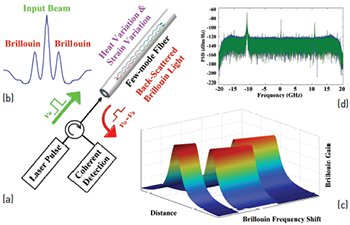 (a) Operating principle of FMF-based optical sensing system. (b) Schematic of Brillouin frequency shift. (c) 3-D Brillouin gain spectrum under temperature and strain variation. (d) Experimental Brillouin spectrum for LP01/11 modes.
(a) Operating principle of FMF-based optical sensing system. (b) Schematic of Brillouin frequency shift. (c) 3-D Brillouin gain spectrum under temperature and strain variation. (d) Experimental Brillouin spectrum for LP01/11 modes.
With their high reliability, compactness and low fabrication cost, optical-fiber sensors based on Brillouin scattering have attracted great interest for use in assessing the performance of civil and geotechnical structures. An imperative issue for such techniques is how to discriminate changes in temperature and strain simultaneously, in a simple, inexpensive field setup. We have now demonstrated a fiber sensor that allows such discrimination, providing readings of both temperature and strain variations from a single measurement at one end of the fiber.
Because the Brillouin frequency shift (BFS) is proportional to variations in both temperature and strain, it’s theoretically impossible to separate these two effects by measuring only one BFS. And, although many methods have been proposed to solve this issue in the past two decades, earlier approaches using single-mode fibers have either shown poor sensing accuracy or added noise and complexity to the system. As few-mode fibers (FMFs) are increasingly used to increase optical communications capacity through space division multiplexing,1 interest has recently grown in developing FMF-based distributed fiber sensors. Such sensors can attain higher spatial resolution and sensitivity compared with conventional single-mode approaches.
In particular, Brillouin dynamic gratings (BDG) and Brillouin optical time-domain analysis (BOTDA) through stimulated Brillouin scattering (SBS) in FMF have been proposed for sensing purposes.2,3 When operating with these techniques, however, light waves must be injected into both ends of the fiber. This increases setup complexity and cost. It could also cause significant issues for geotechnical and petroleum applications, such as the automated monitoring of oil/gas pipelines—if part of the fiber cracks, the measurement can no longer be performed, increasing the danger of undetected pipeline leakage and explosion.
To resolve these problems, in 2015 we proposed and experimentally demonstrated single-end, few-mode Brillouin optical time domain reflectometry (FM-BOTDR), based on the combination of spontaneous Brillouin scattering (SPBS) and heterodyne detection. We showed, through both theoretical analysis and experiment using multi-parameter discriminative measurement techniques, that the system can measure the distribution of strain and temperature simultaneously by light injection only from one end of the fiber.4
Our results confirmed that FMBOTDR performs comparably with two-end methods such as FM-BDG, but with simpler setup and lower cost. Furthermore, we optimized the FMF design by exploiting modal profile and doping concentration, which can provide up to fivefold enhancement in measurement accuracy.5 This novel distributed few-mode sensing system thus provides potentially high sensitivity, and we believe it can prevent catastrophic failure in many applications.
Researchers
Yi Weng and Zhongqi Pan, University of Louisiana, Lafayette, La., USA
Ezra Ip and Ting Wang, NEC Laboratories America, Inc., Princeton, N.J., USA
References
1. D.J. Richardson et al. Nat. Photon. 7, 354 (2013).
2. S. Li et al. Opt. Lett. 37, 4660 (2012).
3. A. Li et al. Opt. Express 21, 31894 (2013).
4. Y. Weng et al. Opt. Express 23, 9024 (2015).
5. Y. Weng et al. Advanced Photonics 2015, OSA Technical Digest, paper SeS3C.3 (2015).
